The 30 × 30 Protection Target: Attitudes of Residents from Seven Countries
Abstract
1. Introduction
2. Materials and Methods
3. Results
3.1. Level of Support for Government to Protect Natural Areas
3.2. Level of Support for Global Target to Protect 30% of the Earth’s Lands, Freshwater Areas, and Oceans by 2030
3.3. Likelihood of Support for Governments to Commit to Protecting 30% of Their Nation’s Lands and Oceans by 2030
3.4. Relative Support for Nature- or Human-Focused Benefits of Protection in Messaging
4. Discussion
5. Conclusions
Author Contributions
Funding
Institutional Review Board Statement
Informed Consent Statement
Data Availability Statement
Acknowledgments
Conflicts of Interest
Appendix A
Appendix A.1. Survey Questions
- National Government
- Local Government Organizations that work across governments
- NGOs
- Businesses and companies
- Communities Individuals
- I want my government to take action to protect areas of diverse wildlife and plant species as well as the land, forests and waterways in our country.
- I am supportive of my government investing in protecting our country’s land, oceans, freshwater areas, and wildlife.
- Many of the problems my country faces can be solved by working with other countries.
- I trust my local government to make the best decisions for our country.
- Decisions made by organizations like the United Nations do not take into account the interests of developing countries, like [my country].
- My government prioritizes global issues that impact all countries.
- I trust my national government to make the best decisions for our country.
- Prevent further environmental damage/Take care of nature/Keep nature safe
- Prevent further environmental damage/Take care of nature/Keep nature safe
- Deforestation/Pollution/Environmental damage
- Plants/Animals/Wildlife/Creatures at risk of extinction
- Decrease harmful impacts/Reduce overuse of resources
- Prevent further environmental damage/Take care of nature/Keep nature safe
- Prevent further environmental damage/Take care of nature/Keep nature safe
- Deforestation/Pollution/Environmental damage
- Plants/Animals/Wildlife/Creatures at risk of extinction
- Decrease harmful impacts/Reduce overuse of resources
- Scientists agree that we must protect at least 30% of nature by the end of this decade in order to counter the dual crises of climate change and the loss of our land, water, and wildlife.
- Since 1970, 70% of the Earth’s wildlife populations have been lost, and this loss is expected to accelerate as the planet continues to warm.
- According to the United Nations, three-quarters of habitats on land and two-thirds of marine habitats have been significantly altered by humans, and as a result, 1 million plant and animal species are threatened with extinction.
- The protection of nature is essential in reducing negative impacts of climate change, but currently, only 16% of the Earth’s land and 8% of global ocean is under protected status.
- Progress is already being made on this initiative as more than 100 countries have committed to protecting at 30% of their lands, waters, and wildlife by 2030, including.
- Protecting 30% of land, freshwaters, and oceans by 2030.
- The [country’s] pledge to conserve and restore 30% of its lands and waters by 2030.
- [Country’s] network of protected areas, conserving examples of natural landscapes and native plants and animals for future generations.
- Efforts to protect and restore 30% of land, freshwaters, and oceans by 2030 will allow us to have more nature in 2030 than we have now.
- Expanding nature conservation efforts to mitigate climate change.
- (a)
- We must protect the Earth’s land, water, and wildlife because all species have a right to live, regardless of their usefulness to humans.
- (b)
- We must protect the Earth’s land, water, and wildlife because they provide many benefits that support human prosperity, health, and well-being.
- Protecting the Earth’s land, water, and wildlife should be a top priority. We should not focus on repairing nature and habitats that have been damaged in the past, but rather focus on conserving what we have left.
- Restoration efforts should be prioritized alongside the protection of the Earth’s land, water, and wildlife. Repairing damaged nature and habitats is essential to overall conservation efforts.
- Experts or scientists
- Environmental NGOs
- National government officials
Appendix B
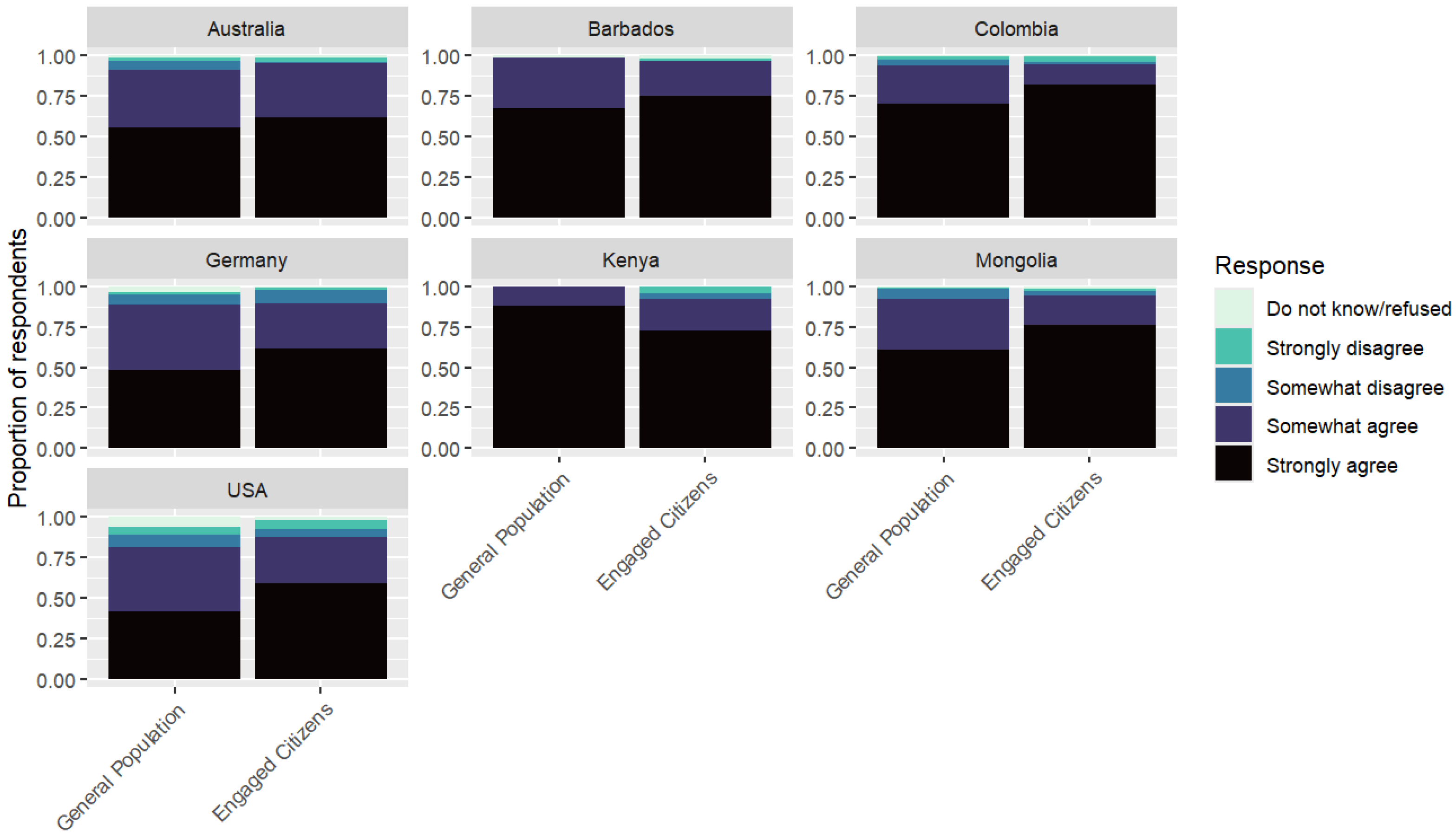


| Country | Strongly Nature for Nature | Somewhat Nature for Nature | Don’t Know/Refused | Somewhat Nature for Humanity | Strongly Nature for Humanity | ||||||||||
|---|---|---|---|---|---|---|---|---|---|---|---|---|---|---|---|
| Gen Pop | Eng Cit | Tot | Gen Pop | Eng Cit | Tot | Gen Pop | Eng Cit | Tot | Gen Pop | Eng Cit | Tot | Gen Pop | Eng Cit | Tot | |
| Australia | 25.5 | 37.7 | 32.5 | 18.9 | 16.4 | 19.5 | 16.0 | 11.9 | 7.3 | 16.0 | 11.9 | 15.8 | 23.6 | 22.0 | 25.0 |
| Barbados | 24.6 | 32.6 | 29.4 | 10.1 | 11.6 | 11.0 | 1.4 | 1.1 | 1.2 | 18.8 | 13.7 | 16.0 | 44.9 | 41.1 | 42.3 |
| Colombia | 50.7 | 51.0 | 50.9 | 7.7 | 5.8 | 6.5 | 1.4 | 1.5 | 1.5 | 7.0 | 5.0 | 5.7 | 33.1 | 36.7 | 35.4 |
| Germany | 39.6 | 38.9 | 39.3 | 16.3 | 15.7 | 16.0 | 8.9 | 8.6 | 8.8 | 15.8 | 8.6 | 12.3 | 19.3 | 28.3 | 23.8 |
| Kenya | 35.3 | 47.5 | 47.0 | 0.0 | 6.3 | 6.0 | 5.9 | 3.4 | 3.5 | 5.9 | 8.4 | 8.3 | 52.9 | 34.5 | 35.3 |
| Mongolia | 32.3 | 37.7 | 34.7 | 16.5 | 15.9 | 16.2 | 3.7 | 0.0 | 2.0 | 16.5 | 11.6 | 14.2 | 31.1 | 34.8 | 33.0 |
| USA | 23.8 | 30.8 | 26.5 | 16.0 | 13.5 | 15.0 | 9.8 | 1.9 | 6.8 | 22.5 | 21.8 | 22.3 | 27.9 | 32.1 | 29.5 |
References
- Rodríguez-Rodríguez, D.; Martínez-Vega, J. Effectiveness of Protected Areas in Conserving Biodiversity; Strategies for Sustainability; Springer Nature: Cham, Switzerland, 2022. [Google Scholar] [CrossRef]
- Figgis, P.; Mackey, B.; Fitzsimons, J.; Irving, J.; Clarke, P. (Eds.) Valuing Nature: Protected Areas and Ecosystem Services; Australian Committee for IUCN: Sydney, Australia, 2015. [Google Scholar]
- Stolton, S.; Dudley, N.; Avcıoğlu Çokçalışkan, B.; Hunter, D.; Ivanić, K.-Z.; Kanga, E.; Kettunen, M.; Kumagai, Y.; Maxted, N.; Senior, J.; et al. Values and benefits of protected areas. In Protected Area Governance and Management; Worboys, G.L., Lockwood, M., Kothari, A., Feary, S., Pulsford, I., Eds.; ANU Press: Canberra, Australia, 2015; pp. 145–168. [Google Scholar]
- Convention on Biological Diversity. Kunming-Montreal Global Biodiversity Framework, 15th Meeting of the Conference of Parties to the UN Convention on Biological Diversity, CBD/COP/15/L25. 2022. Available online: https://www.cbd.int/article/cop15-final-text-kunming-montreal-gbf-221222 (accessed on 3 January 2025).
- Carroll, C.; Noss, R.F. How percentage-protected targets can support positive biodiversity outcomes. Conserv. Biol. 2022, 36, e13869. [Google Scholar] [CrossRef]
- Leadley, P.; Gonzalez, A.; Obura, D.; Krug, C.B.; Cecilia Londono-Murcia, M.; Millette, K.L.; Radulovici, A.; Rankovic, A.; Shannon, L.J.; Archer, E.; et al. Achieving global biodiversity goals by 2050 requires urgent and integrated actions. One Earth 2022, 5, 597–603. [Google Scholar] [CrossRef]
- Zeng, Y.; Senior, R.A.; Crawford, C.L.; Wilcove, D.S. Gaps and weaknesses in the global protected area network for safeguarding at-risk species. Sci. Adv. 2023, 9, eadg0288. [Google Scholar] [CrossRef]
- Robinson, J.G.; LaBruna, D.; O’Brien, T.; Clyne, P.J.; Dudley, N.; Andelman, S.J.; Bennett, E.L.; Chicchon, A.; Durigan, C.; Grantham, H.; et al. Scaling up area-based conservation to implement the Global Biodiversity Framework’s 30x30 target: The role of Nature’s Strongholds. PloS Biol. 2024, 22, e3002613. [Google Scholar] [CrossRef]
- Sheridan, P. False polemics or real consensus? What Australians really think about marine protected areas. In Big, Bold and Blue: Lessons from Australia’s Marine Protected Areas; Fitzsimons, J., Wescott, G., Eds.; CSIRO Publishing: Melbourne, Australia, 2016; pp. 339–349. [Google Scholar]
- Jones, N.; McGinlay, J.; Kontoleon, A.; Maguire-Rajpaul, V.A.; Dimitrakopoulos, P.G.; Gkoumas, V.; Riseth, J.Å.; Sepp, K.; Vanclay, F. Understanding public support for European protected areas: A review of the literature and proposing a new approach for policy makers. Land 2022, 11, 733. [Google Scholar] [CrossRef]
- Jones, N.; Malesios, C.; McGinlay, J.; Villasante, S.; Svajda, J.; Kontoleon, A.; Begley, A.; Gkoumas, V.; Cadoret, A.; Dimitrakopoulos, P.G.; et al. Using perceived impacts, governance and social indicators to explain support for protected areas. Environ. Res. Lett. 2023, 18, 054011. [Google Scholar] [CrossRef]
- Cunha, H.F.A.; de Souza, A.F.; Cardoso da Silva, J.M. Public support for protected areas in new forest frontiers in the Brazilian Amazon. Environ. Conserv. 2019, 46, 278–284. [Google Scholar] [CrossRef]
- McGinlay, J.; Jones, N.; Malesios, C.; Dimitrakopoulos, P.G.; Begley, A.; Berzborn, S.; Botsch, K.; Gkoumas, V.; Kontoleon, A.; Külm, S.; et al. Exploring local public support for protected areas: What social factors influence stated and active support among local people? Environ. Sci. Pol. 2023, 145, 250–261. [Google Scholar] [CrossRef]
- Baker, R.; Brick, J.M.; Bates, N.A.; Battaglia, M.; Couper, M.P.; Dever, J.A.; Gile, K.A.; Tourangeau, R. Summary report of the AAPOR task force on non-probability sampling. J. Surv. Statist. Methodol. 2013, 1, 90–143. [Google Scholar] [CrossRef]
- Brick, J.M.; Williams, D. Explaining rising nonresponse rates in cross-sectional surveys. Ann. Am. Acad. Pol. Soc. Sci. 2013, 645, 36–59. [Google Scholar] [CrossRef]
- Callegaro, M.; Villar, A.; Yeager, D.; Krosnick, J.A. A Critical review of studies investigating the quality of data obtained with online panels based on probability and nonprobability samples. In Online Panel Research: A Data Quality Perspective; Callegaro, M., Baker, R., Bethlehem, J., Göritz, A.S., Krosnick, J.A., Lavrakas, P.J., Eds.; John Wiley and Sons: London, UK, 2014; pp. 23–53. [Google Scholar] [CrossRef]
- Daněk, J.; Blättler, L.; Leventon, J.; Vačkářová, D. Beyond nature conservation? Perceived benefits and role of the ecosystem services framework in protected landscape areas in the Czech Republic. Ecosyst. Serv. 2023, 59, 101504. [Google Scholar] [CrossRef]
- Sandbrook, C.; Albury-Smith, S.; Allan, J.R.; Bhola, N.; Bingham, H.C.; Brockington, D.; Byaruhanga, A.B.; Fajardo, J.; Fitzsimons, J.; Franks, P.; et al. Social considerations are crucial to success in implementing the 30 × 30 global conservation target. Nat. Ecol. Evol. 2023, 7, 784–785. [Google Scholar] [CrossRef]
- Sibanda, L.; Dickman, A.; Hughes, C.; Tacey, J.; Madsen, E.; Mandoloma, L.; Mbizah, M.M.; Mutinhima, Y.; Rono, B.; Kulunge, S.; et al. Avoiding an impending collision in international conservation. Conserv. Biol. 2025, 39, e14450. [Google Scholar] [CrossRef]
- Fitzsimons, J.; Picone, A.; Partridge, T.; Cornish, M. Protecting Australia’s Nature: Pathways to Protecting 30 Percent of Land by 2030; The Nature Conservancy, WWF-Australia, the Australian Land Conservation Alliance and the Pew Charitable Trusts: Melbourne, Australia, 2023. [Google Scholar]
- Fitzsimons, J.A.; Partridge, T.; Keen, R. Other Effective Area-based Conservation Measures (OECMs) in Australia: Key considerations for assessment and implementation. Conservation 2024, 4, 176–200. [Google Scholar] [CrossRef]
- Jonas, H.D.; Bingham, H.C.; Bennett, N.J.; Woodley, S.; Zlatanova, R.; Howland, E.; Belle, E.; Upton, J.; Gottlieb, B.; Kamath, V.; et al. Global status and emerging contribution of other effective area-based conservation measures (OECMs) towards the ’30 × 30’ biodiversity Target 3. Front. Conserv. Sci. 2024, 5, 1447434. [Google Scholar] [CrossRef]
- Lewis, A.H.; Gottlieb, B.; Wilson, B.; Sutton, J.; Lessmann, J.; Delli, G.; Dubois, G.; Bingham, H.C. Coverage and beyond: How can private governance support key elements of the Global Biodiversity Framework’s Target 3? Front. Conserv. Sci. 2023, 4, 1303801. [Google Scholar] [CrossRef]
- Dreiss, L.M.; Malcom, J.W. Identifying key federal, state, and private lands strategies for achieving 30 × 30 in the United States. Conserv. Lett. 2022, 15, e12849. [Google Scholar] [CrossRef]
- UNEP-WCMC; IUCN. Protected Planet Report 2024; UNEP-WCMC and IUCN: Cambridge, UK; Gland, Switzerland, 2024. [Google Scholar]
- McDonald, G.; Bone, J.; Costello, C.; Englander, G.; Raynor, J. Global expansion of marine protected areas and the redistribution of fishing effort. Proc. Natl. Acad. Sci. USA 2024, 121, e2400592121. [Google Scholar] [CrossRef]
- Günther, P.; Ekardt, F. Balancing climate goals and biodiversity protection: Legal implications of the 30 × 30 target for land-based carbon removal. Front. Clim. 2023, 5, 1276606. [Google Scholar] [CrossRef]
- Palomo, I.; González-García, A.; Ferraro, P.J.; Muradian, R.; Pascual, U.; Arboledas, M.; Bullock, J.M.; Bruley, E.; Gómez-Baggethun, E.; Lavorel, S. Business-as-usual trends will largely miss 2030 global conservation targets. Ambio 2025, 54, 212–224. [Google Scholar] [CrossRef]
- Thapa, K.; King, D.; Diedrich, A. The influence of perceptions and demographic factors on local support for protected areas. Conserv. Sci. Pract. 2025, 7, e70003. [Google Scholar] [CrossRef]
- Michaelsen, P.; Sundström, A.; Jagers, S.C. Mass Support for Conserving 30% of the Earth by 2030: Experimental Evidence from Five Continents; QoG Working Paper Series 2024: 14; University of Gothenburg: Gothenburg, Sweden, 2024; Available online: https://www.gu.se/sites/default/files/2024-12/2024_14_Michaelsen_Sundstrom_Jagers.pdf (accessed on 4 January 2025).
- Biodiversity Council. 2024−2025 Biodiversity Concerns Report: A Survey of Community Attitudes Toward Nature Conservation; Biodiversity Council: Melbourne, Australia, 2025; Available online: https://biodiversitycouncil.org.au/admin/uploads/2025_Biodiversity_Council_Community_Concerns_Report_ee239c6469.pdf (accessed on 1 April 2025).
- Watson, J.E.M.; Venegas-Li, R.; Grantham, H.; Dudley, N.; Stolton, S.; Rao, M.; Woodley, S.; Hockings, M.; Burkart, K.; Simmonds, J.S.; et al. Priorities for protected area expansion so nations can meet their Kunming-Montreal Global Biodiversity Framework commitments. Integr. Conserv. 2023, 2, 140–155. [Google Scholar] [CrossRef]
- Bell-James, J.; Foster, R.; Shumway, N.; Lovelock, C.E.; Villarreal-Rosas, J.; Brown, C.J.; Andradi-Brown, D.A.; Saunders, M.I.; Waltham, N.J.; Fitzsimons, J.A. The Global Biodiversity Framework’s ecosystem restoration target requires more clarity and careful legal interpretation. Nat. Ecol. Evol. 2024, 8, 840–841. [Google Scholar] [CrossRef]
- Australian Government. Australia’s Strategy for Nature: 2024–2030 Australia’s National Biodiversity Strategy and Action Plan; Australian Government: Canberra, Australia, 2024.
- Fitzsimons, J.A.; Hazin, C.; Smith, J.L. Common misconceptions of ‘other effective area-based conservation measures’ (OECMs) and implications for global conservation targets. npj Biodivers. 2025, 4, 8. [Google Scholar] [CrossRef]
- von Staden, L.; Holness, S.D.; Lombard, A.T. Can strategic protected area expansion solve the insufficient representation of biodiversity in protected area networks? A case study from South Africa. Biol. Conserv. 2025, 302, 110903. [Google Scholar] [CrossRef]
- Carter, S.K.; Keuler, N.S.; Pidgeon, A.M.; Radeloff, V.C. Evaluating the influence of conservation plans on land protection actions in Wisconsin, USA. Biol. Conserv. 2014, 178, 37–49. [Google Scholar] [CrossRef]
- Bell-James, J.; Watson, J.E.M. Ambitions in national plans do not yet match bold international protection and restoration commitments. Nat. Ecol. Evol. 2025, 9, 417–424. [Google Scholar] [CrossRef]
- Li, Q.; Ge, Y.; Sayer, J.A. Challenges to implementing the Kunming-Montreal Global Biodiversity Framework. Land 2023, 12, 2166. [Google Scholar] [CrossRef]
- Hughes, A.C. The Post-2020 Global Biodiversity Framework: How did we get here, and where do we go next? Integr. Conserv. 2023, 2, 1–9. [Google Scholar] [CrossRef]
- Bennett, N.J.; Roth, R.; Klain, S.C.; Chan, K.; Christie, P.; Clark, D.A.; Cullman, G.; Curran, D.; Durbin, T.J.; Epstein, G.; et al. Conservation social science: Understanding and integrating human dimensions to improve conservation. Biol. Conserv. 2017, 205, 93–108. [Google Scholar] [CrossRef]
- Bocking, S. Science and conservation: A history of natural and political landscapes. Environ. Sci. Policy 2020, 113, 1–6. [Google Scholar] [CrossRef]
- Flynn, C.; Yamasumi, E.; Fisher, S.; Snow, D.; Grant, Z.; Kirby, M.; Browning, P.; Rommerskirchen, M.; Russell, I. Peoples’ Climate vote; United Nations Development Programme and University of Oxford: New York, NY, USA, 2021. [Google Scholar]
- Halkos, G.; Matsiori, S. Understanding the public’s perceptions of the importance, management, and conservation of biodiversity. Econ. Anal. Policy 2022, 75, 262–270. [Google Scholar] [CrossRef]
- Nagai, K. The representation of public opinion in reporting poll results on environment issues. Front. Commun. 2023, 8, 1225306. [Google Scholar] [CrossRef]
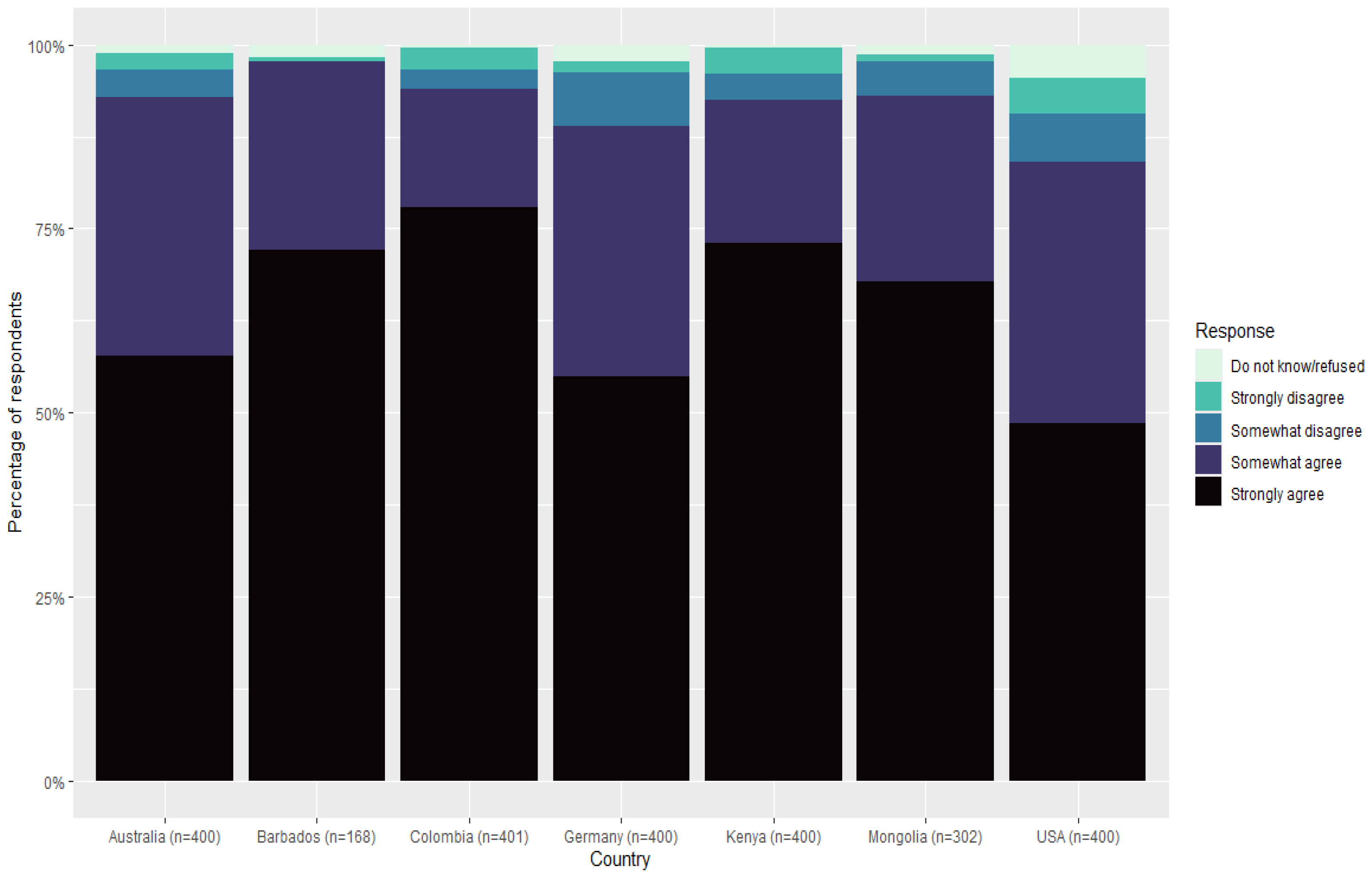
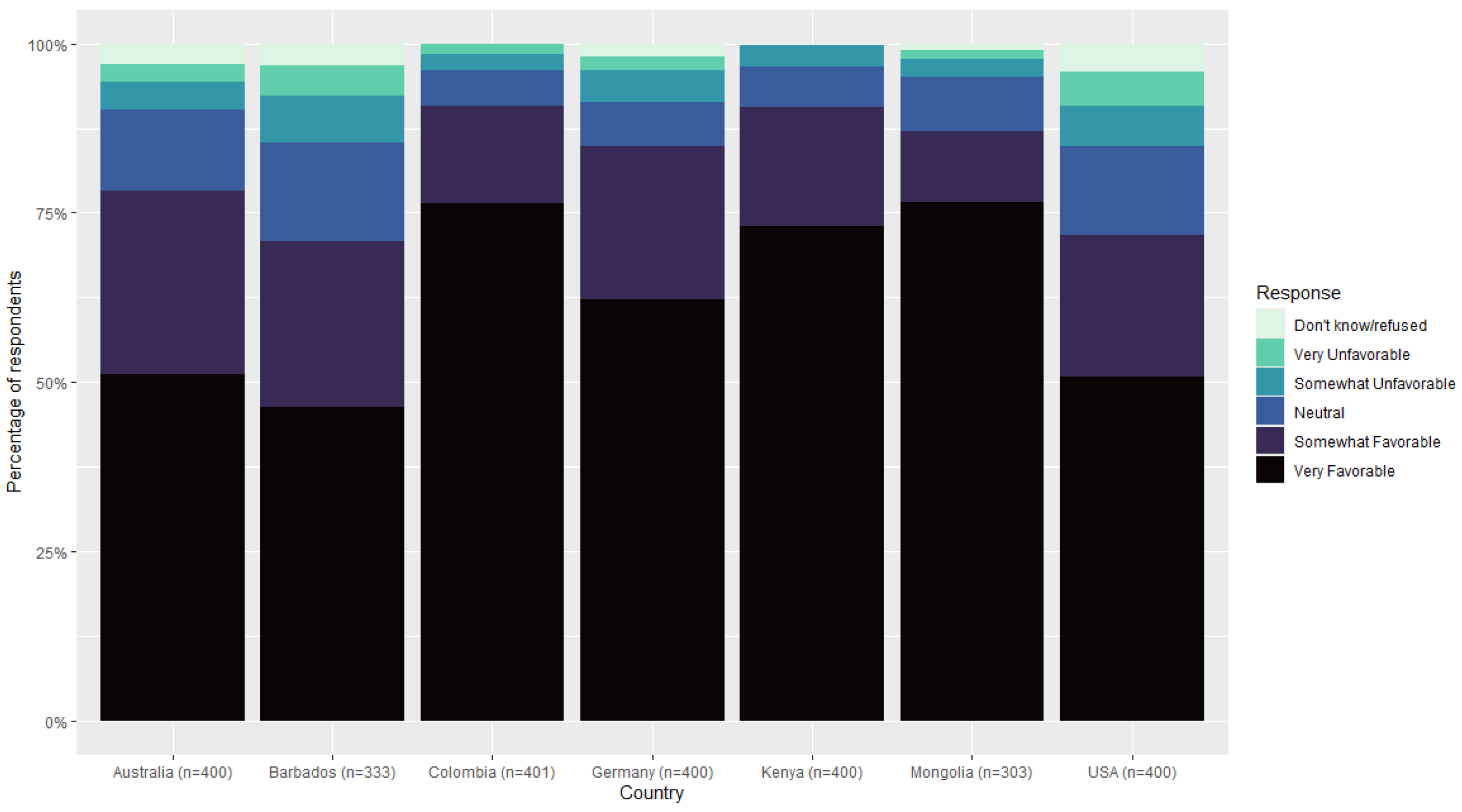
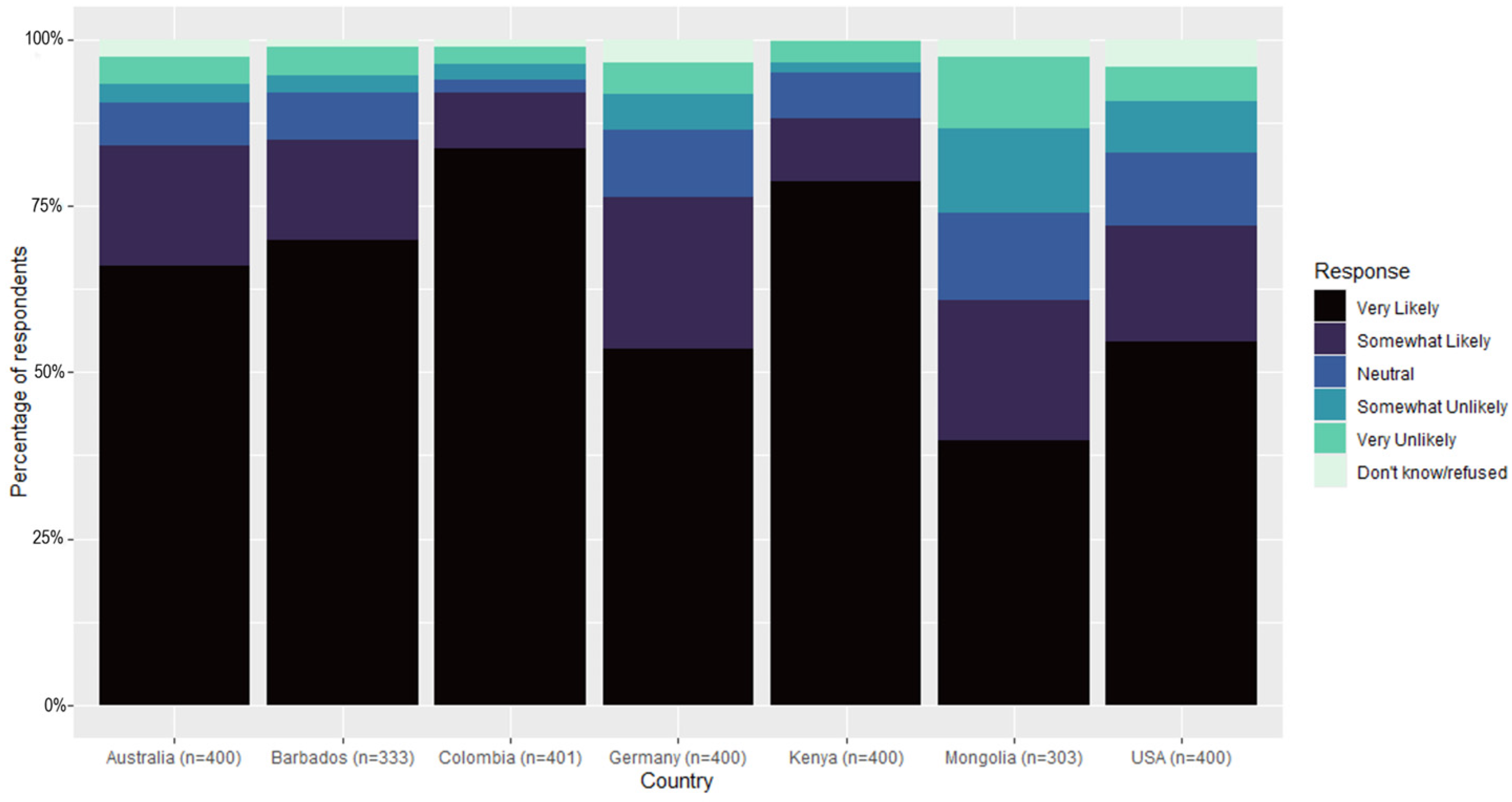
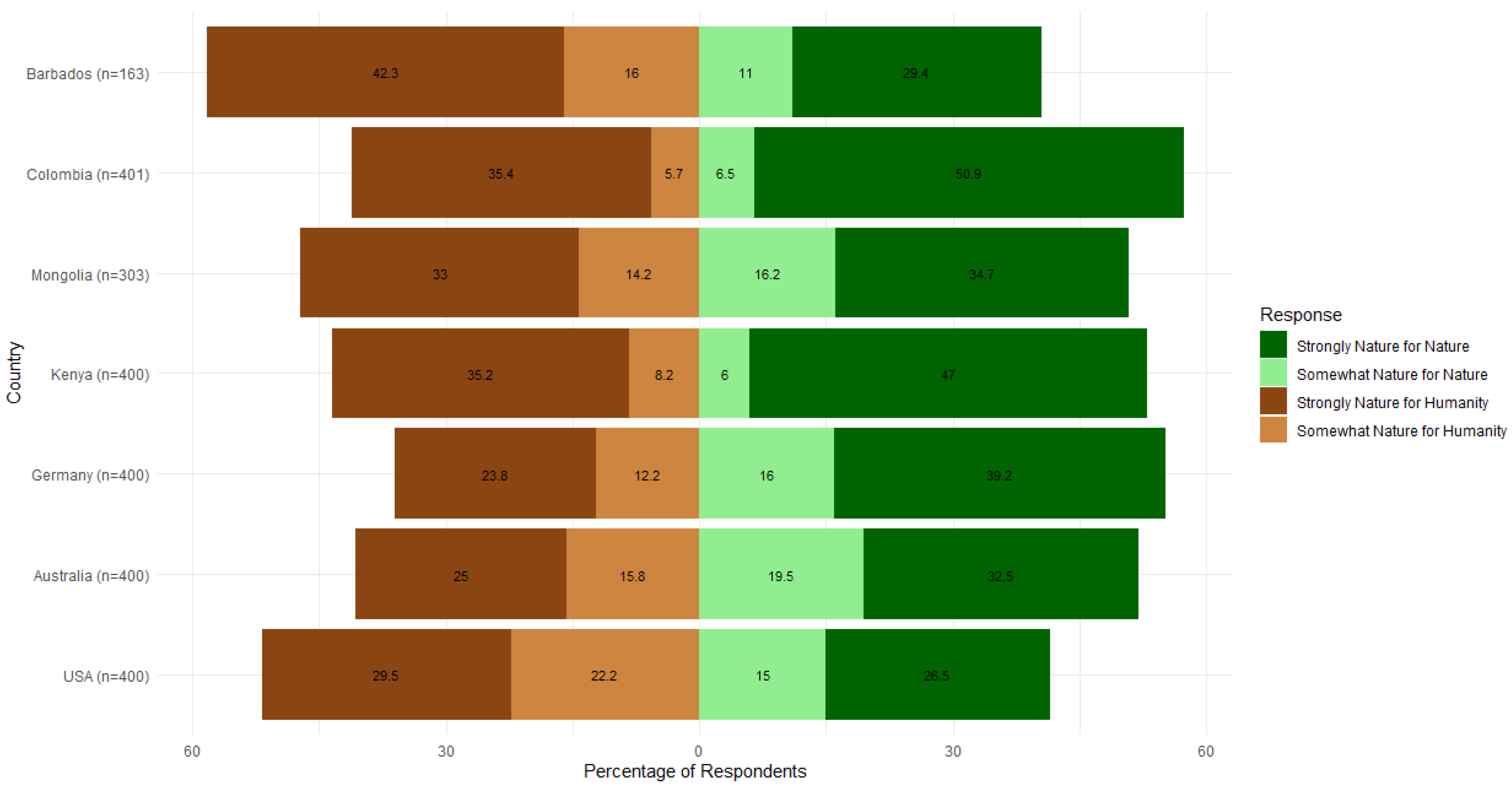
| Country | Total Responses | General Public | Engaged Citizens |
|---|---|---|---|
| USA | 400 | 244 (61.0%) | 156 (39.0%) |
| Australia | 400 | 253 (63.3%) | 147 (36.8%) |
| Germany | 400 | 202 (50.5%) | 198 (49.5%) |
| Kenya | 400 | 17 (4.3%) | 383 (95.8%) |
| Mongolia | 303 | 164 (54.1%) | 139 (45.9%) |
| Colombia | 401 | 142 (35.4%) | 259 (64.6%) |
| Barbados | 333 * | 141 (42.3%) | 192 (67.7%) |
| TOTAL | 2637 | 1163 (44.1%) | 1474 (55.9%) |
Disclaimer/Publisher’s Note: The statements, opinions and data contained in all publications are solely those of the individual author(s) and contributor(s) and not of MDPI and/or the editor(s). MDPI and/or the editor(s) disclaim responsibility for any injury to people or property resulting from any ideas, methods, instructions or products referred to in the content. |
© 2025 by the authors. Licensee MDPI, Basel, Switzerland. This article is an open access article distributed under the terms and conditions of the Creative Commons Attribution (CC BY) license (https://creativecommons.org/licenses/by/4.0/).
Share and Cite
Fitzsimons, J.A.; Garrison, K.; Finnegan, B.; Luby, I. The 30 × 30 Protection Target: Attitudes of Residents from Seven Countries. Sustainability 2025, 17, 3444. https://doi.org/10.3390/su17083444
Fitzsimons JA, Garrison K, Finnegan B, Luby I. The 30 × 30 Protection Target: Attitudes of Residents from Seven Countries. Sustainability. 2025; 17(8):3444. https://doi.org/10.3390/su17083444
Chicago/Turabian StyleFitzsimons, James A., Kellyn Garrison, Blinne Finnegan, and Ian Luby. 2025. "The 30 × 30 Protection Target: Attitudes of Residents from Seven Countries" Sustainability 17, no. 8: 3444. https://doi.org/10.3390/su17083444
APA StyleFitzsimons, J. A., Garrison, K., Finnegan, B., & Luby, I. (2025). The 30 × 30 Protection Target: Attitudes of Residents from Seven Countries. Sustainability, 17(8), 3444. https://doi.org/10.3390/su17083444







